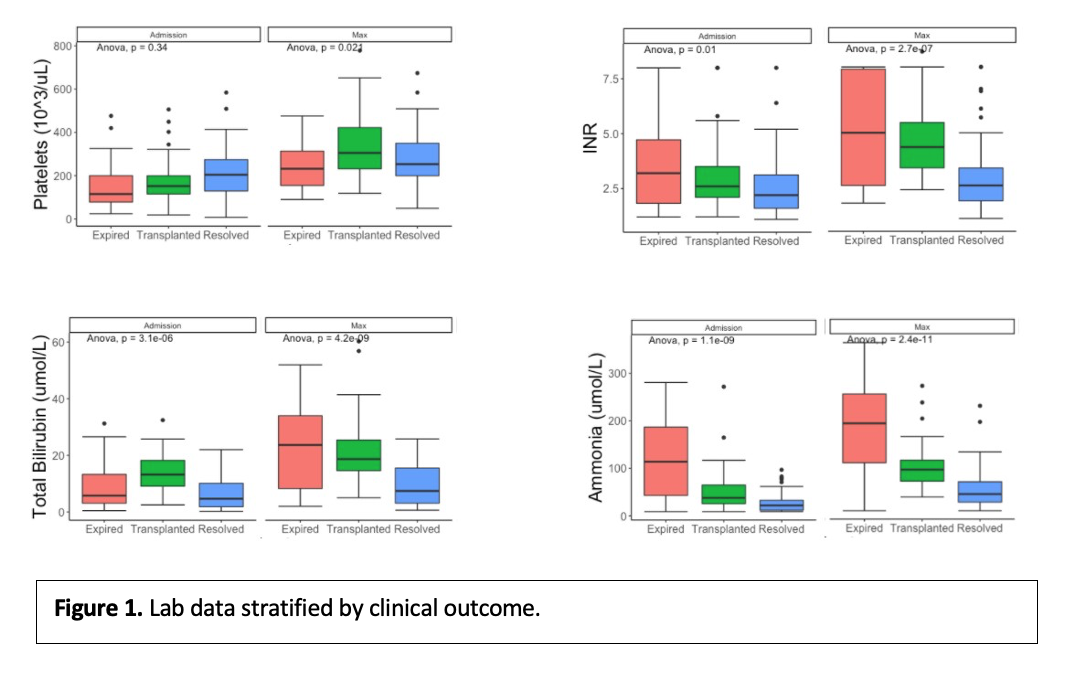Pediatric Acute Liver Failure: Patient Factors Associated with Higher Mortality
1Children's Hospital Los Angeles, Los Angeles, CA, 2University of Southern California, Los Angeles, CA
Meeting: 2022 American Transplant Congress
Abstract number: 1461
Keywords: Liver failure, Mortality, Pediatric
Topic: Clinical Science » Liver » 61 - Liver: Pediatrics
Session Information
Session Time: 7:00pm-8:00pm
 Presentation Time: 7:00pm-8:00pm
Presentation Time: 7:00pm-8:00pm
Location: Hynes Halls C & D
*Purpose: Pediatric acute liver failure (PALF) is characterized by sudden onset deteriorating liver function, progressive coagulopathy, and hepatic encephalopathy in previously healthy children. The clinical trajectory of PALF is highly unpredictable. Herein, clinical variables associated with PALF outcomes in a large, highly diverse single-center experience were examined.
*Methods: A retrospective cohort of children (<18 years) admitted with PALF at our center between 2001-2021 were identified by ICD codes. Clinical variables were stratified by outcome (spontaneous recovery, liver transplant (LT), death) for analysis.
*Results: Overall, 116 patients were identified. The median age at presentation was 5.2 years [1.8, 13.8] (IQR), with 49% female and 39.7% Hispanic. Most patients recovered (51.7%), while 37% underwent LT and 11.2% died. Children <1 year accounted for most deaths (53.8%, p<0.01), while children >12 years more often recovered (40%, p<0.01) and children ages 4-12 were most likely to receive LT (44%, p<0.01). Indeterminate PALF was the most common etiology (28.4%, p<0.01). When compared to patients who recovered or received LT, patients who died without LT had higher admission INR (p=0.01), peak INR (p<0.005), and average INR (p<0.001); peak total bilirubin (TB, p<0.001), higher average AST (p=0.005), lower average platelet counts (p<0.001), and higher peak GGT (p=0.036) (Figure 1). Ammonia, a marker of encephalopathy, was higher on average (p<0.001) and peaked at a higher level (p<0.001) in patients who died without LT.
*Conclusions: This single center review of PALF demonstrates that children <1 year old experience greater mortality and that children >12 years are most likely to recover without LT. Patients who die without LT are more likely to have significant elevations in INR, GGT, AST, TB, and ammonia, with worse thrombocytopenia. Further investigation of lab value trajectory in PALF is being explored to develop a predictive model for PALF outcomes.
To cite this abstract in AMA style:
Bartlett JAscher, Weaver C, Barhouma S, Houshmand L, Rocque B, Etesami K, Kohli R, Emamaullee J. Pediatric Acute Liver Failure: Patient Factors Associated with Higher Mortality [abstract]. Am J Transplant. 2022; 22 (suppl 3). https://atcmeetingabstracts.com/abstract/pediatric-acute-liver-failure-patient-factors-associated-with-higher-mortality/. Accessed December 20, 2025.« Back to 2022 American Transplant Congress

